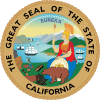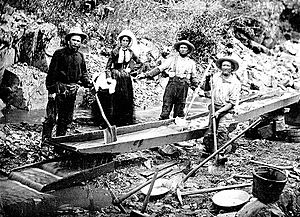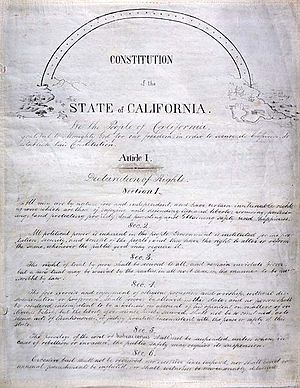Act for the Government and Protection of Indians facts for kids
Quick facts for kids Act for the Government and Protection of Indians |
|
|---|---|
 |
|
| California State Legislature | |
| Full name | Act for the Government and Protection of Indians |
| Assembly voted | April 19, 1850 |
| Signed into law | April 22, 1850 |
| Sponsor(s) | Chamberlin, Bidwell |
| Code | California Statutes, 1850 |
| Section | Chapter 133 |
| Website | [1][2] |
|
Status: Repealed
|
|
The Act for the Government and Protection of Indians was a law passed in California on April 22, 1850. It was also known as the Indian Indenture Act. This law was signed by California's first Governor, Peter Hardeman Burnett.
The Act allowed for many Native Americans in California to be forced into labor. It also set rules for their jobs and changed how crimes were handled. This law played a big part in the California genocide, a time when thousands of Native Californians were killed or forced into slavery by white settlers during the California Gold Rush.
Governor Burnett said in 1851 that he expected a "war" between races until Native Americans were gone. When the law was passed, Native Californians could not become citizens, vote, or speak in court. The Act made it easier to remove Native Californians from their homes. It separated many children and adults from their families, languages, and cultures between 1850 and 1865.
It is hard to know exactly how many Native Americans were forced into labor because of this law. Between 1850 and 1870, the Native Californian population in Los Angeles dropped from 3,693 to 219 people. Even though parts of the law were canceled after slavery was ended in 1865, the entire Act was not removed until 1937. In 2019, Governor Gavin Newsom said sorry on behalf of California for this law.
Contents
Understanding the Background
The California Gold Rush Era
Before 1846, fewer than 15,000 non-Native people lived in California. But during the California Gold Rush, this number grew to 100,000. This led to problems between miners and Native people.
Early in the Gold Rush, groups of miners attacked and killed Indigenous people. This caused many massacres. Native groups became smaller and weaker. They were already struggling with sickness and not enough food.
California also passed laws that gave money to people who hunted Native Americans. This meant public money was used to harm Native people. This created a terrible history of violence against Native Americans in California.
In July 1846, the United States took control of California. To try and solve problems, General Stephen W. Kearny appointed John Sutter and Mariano Guadalupe Vallejo to help Native Californians. But their actions were not peaceful or protective.
Lieutenant William Tecumseh Sherman even allowed people to shoot Native people if they were caught stealing a horse. Native workers had to carry special papers starting in November 1847. If they didn't have these papers, they were treated as horse-thieves and arrested. At the same time, the U.S. government said Native Americans could not sell their own land.
In 1849, the President sent Thomas Butler King to study California's conditions, especially about Native people. King's report wrongly said that Native Californians were not willing to work or improve their lives. He thought they needed to be taught "civilized" ways. Another report by Adam Johnston said similar things. These reports likely influenced the laws that followed.
California's First Constitution
In 1849, California wrote its first constitution. There was a debate about whether Native Californians should be allowed to vote. Some people argued they should, but most disagreed. So, Native people in California were not allowed to vote.
On April 22, 1850, the first California Legislature passed the Act for the Government and Protection of Indians. It was first called "An Act relative to the protection, punishment, and government of Indians."
Key Parts of the Act
This Act made it easier to remove Indigenous groups from their homes in California. It also separated many children and adults from their culture, families, and languages. The law also allowed Native people to be forced into labor for white people.
Here are some important parts of this Act:
- Section 3: Employers could take Native children and keep them until they were 18 for boys and 15 for girls. A parent or friend had to agree to this.
- Section 4: People who had Native individuals in their care had to treat them properly. If they didn't, they could be fined at least 10 dollars.
- Section 6: White people or Native people could make complaints to a Justice of the Peace. But a white person could never be found guilty based only on what a Native person said.
- Section 9: If Native tribes or villages did not follow the laws set by Justices of the Peace, the Justice could punish their leaders. This could be a warning, a fine, or other reasonable punishment.
- Section 13: Justices could ask Native leaders to find and bring any Native person suspected of a crime to them.
- Section 14: If a Native person was found guilty of a crime and had to pay a fine, a white person could pay the fine for them. In return, the Native person would have to work for that white person until the debt was paid off.
- Section 16: A Native person found guilty of stealing animals or other valuable things could be whipped up to 25 times. They could also be fined up to 200 dollars. The court or jury would decide the punishment.
- Section 20: Any Native person found wandering, begging, or living an "immoral" life could be arrested. An officer would then hire out this person to the highest bidder within 24 hours. The money earned would go to the County Treasury for an "Indian Fund." If the person had a family, the money would go to them.
Changes to the Law
Minor changes were made to the Act over time. In 1860, amendments were passed. Section 3 was changed to allow Native children to be kept for work or training until they were 40 for men and 37 for women. Younger Native people could also be taken without their parents' permission.
Section 7 was changed to fine anyone who forced a Native American into labor outside of this Act. Later, in 1872, Section 6 was removed. Also in 1872, the California Constitution was changed to allow Native Americans to speak in court.
How the Act Was Used
This Act allowed any Native American who was "strolling about" to be called a "vagrant" by a white person. They could then be taken to a judge and sold at a public auction. White Americans often used this part of the law too much.
Ranchers and landowners often paid their Native American workers with alcohol. This meant public drunkenness was common, leading to many arrests and forced labor. After a few months, enslaved Native Americans were often sent back to the streets. This way, they could be declared "vagrants" again and forced back into labor.
These auctions happened in the streets of Los Angeles. They were like a busy slave market from 1850 to 1870. Many men made money from these auctions. Young Native Californians were sold for $30 to $150.
In 1851 and 1852, the California Legislature offered money to encourage attacks on Native people. They approved $1,100,000 for "stopping Indian hostilities." More money was approved in 1857.
In April 1863, after the Emancipation Proclamation, California ended the forced labor of Native Americans. The law was fully removed in 1866. This happened after the 14th Amendment was added to the U.S. Constitution. This amendment said that no state could take away a citizen's rights or property without a fair process. It also said everyone should have equal protection under the law.
Forced labor slowly ended in the 1870s. This was partly because the Native American population was decreasing. Also, more immigrants from China and Europe were arriving.
Treaties and Negotiations
In 1851, the U.S. government started making treaties with Native tribes in California. By 1852, 18 treaties were made. These treaties set aside almost 7.5 million acres of land, about one-third of California, just for Native use. The treaties also promised food and resources to help tribes become self-sufficient.
However, the California State Senate quickly opposed these treaties. They did not want to give large amounts of good farmland to Native people. The United States government never approved these treaties.
In 1852, Edward Fitzgerald Beale became the first Superintendent of Indian Affairs in California. He planned to create at least five reserves. Congress gave $200,000 for this. The Tejon Reserve was set up in September 1853. About 2,000 Native people were brought to this 50,000-acre land. But Beale did not help many other Native Californians who needed it. He was removed from his job in 1854.
His replacement, Col. Thomas J. Henley, set up other reservations. These included Nome Lacklee, Nome Cult, Fresno Indian Farm, and Kings River Indian Farm. These places had problems with damaged crops and not enough water, leading to poor living conditions. Eventually, the government gave up ownership, and Native people were forced to move again.
In 1870, religious groups like the Quakers, Methodists, and Baptists took over the reservations. These groups often did not respect Native American traditional beliefs. Turning reservations into missions was one of the first ways to try and make Native people fit into the general population.
Similar Laws
The Act for the Government and Protection of Indians was similar to other laws passed in California at that time. These included the Greaser Act in 1855 and the Foreign Miners' Tax Act of 1850.
Lasting Impact
This Act had a terrible impact on the Native population of California. Before the Gold Rush, between 100,000 and 150,000 Native people lived in California. The places where these injustices happened are now important protest sites for Native groups.
The effects of the Act lasted long after it was repealed. Native Californians were not allowed to vote, even after the 15th Amendment was passed, which said all U.S. citizens had the right to vote. Native Californians finally gained the right to vote when the Federal Citizenship Act of 1924 was passed.
Images for kids




